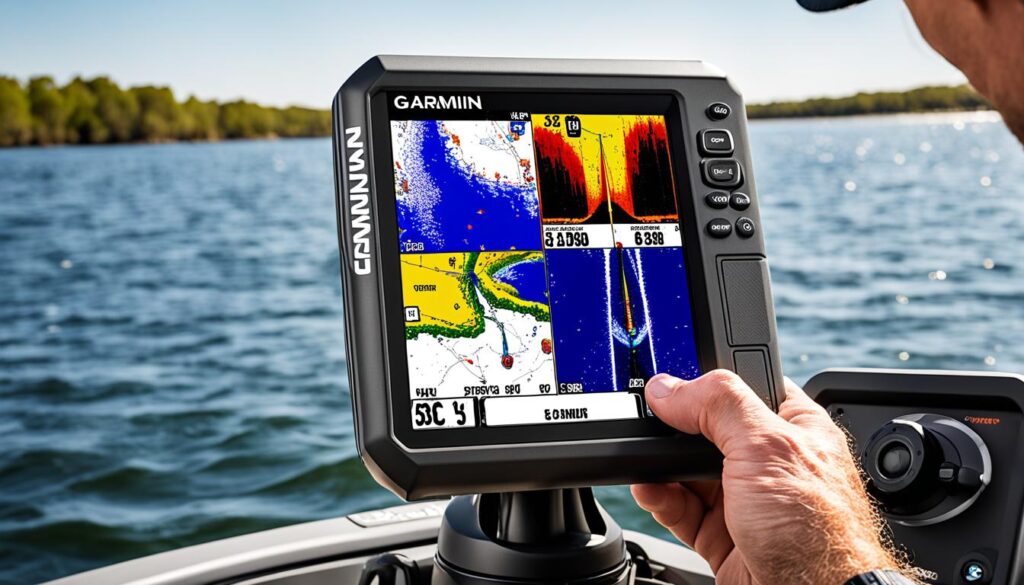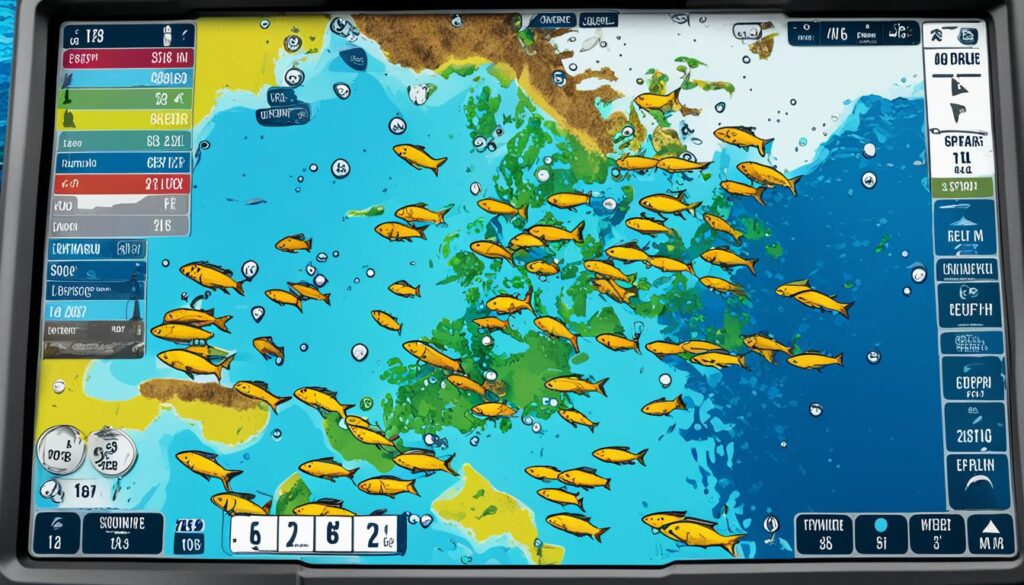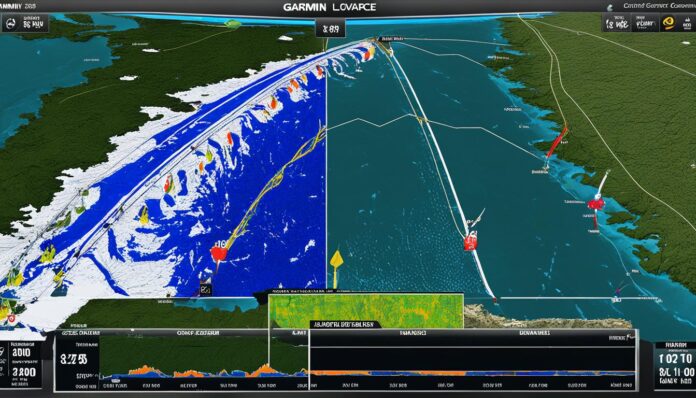As an Amazon Associate, I earn from qualifying purchases
Choosing the right fish finder can be a challenging task, especially with the rapid advancements in technology. Two of the most popular brands in the market are Garmin and Lowrance. In this article, we will compare the main features of these fish finders to help you make an informed decision on which brand is the best choice for your marine electronics needs.
When evaluating Garmin and Lowrance fish finders, we will consider factors such as screen size, performance, expansion options, price, and common specifications and features. By exploring these aspects, you will gain a comprehensive understanding of the differences between these two top fish finder brands.
Key Takeaways:
- Garmin and Lowrance are two leading brands in the fish finder market.
- Factors to consider when choosing a fish finder include screen size, performance, expansion options, and price.
- Both Garmin and Lowrance offer a range of models with different features and capabilities.
- Garmin excels in imaging technology and built-in GPS, while Lowrance provides affordability and high-quality 2D, DI, and SI imaging.
- Ultimately, the best fish finder brand for you will depend on your specific fishing requirements and budget.
Factors to Consider When Choosing a Fish Finder
When deciding between Garmin and Lowrance fish finders, there are several important factors to consider. Let’s take a closer look at each one:
1. Fish Finder Screen Size
Screen size is a crucial consideration when choosing a fish finder. You want to ensure that the screen size is suitable for your boat and the mounting location. A larger screen size provides a more detailed view of the underwater terrain and makes it easier to identify fish and structures.
2. Fish Finder Performance
The performance of a fish finder determines the depth range and image quality you can achieve. Look for features like high-frequency sonar, CHIRP technology, and Down Imaging to get clear and detailed images of what’s beneath the water’s surface. Consider the power and sensitivity settings as they influence the accuracy and effectiveness of the fish finder.
3. Fish Finder Expansion Options
Expansion options are worth considering if you plan on enhancing your fish finder with additional features in the future. Look for fish finders that offer options for networking and expansion, such as radar or AIS integration, to keep up with your evolving fishing needs.
4. Fish Finder Price
Price is always a crucial factor to consider when making any purchase. Fish finder prices can vary widely depending on the brand, features, and specifications. Set a budget and look for fish finders that offer the best value for your money without compromising on essential features and performance.
“Choosing the right fish finder involves considering screen size, performance, expansion options, and price.”
To help you understand these factors better, let’s take a look at the table below comparing these features for Garmin and Lowrance fish finders:
| Feature | Garmin Fish Finders | Lowrance Fish Finders |
|---|---|---|
| Screen Size | Various sizes available, ranging from X inches to X inches | Various sizes available, ranging from X inches to X inches |
| Performance | Advanced sonar technologies, including ClearVü and SideVü scanning sonar | Quality imaging with CHIRP sonar technology |
| Expansion Options | NMEA2000, Ethernet, radar, and AIS compatibility | NMEA2000, Ethernet, radar, and AIS compatibility |
| Price | Range from $X to $X | Range from $X to $X |
Remember, this is just a general overview, and specific models may offer additional features or variations. Consider your fishing needs and priorities before making a decision.
Now that you have a better understanding of the factors to consider when choosing a fish finder, you can make a more informed decision based on your specific requirements and preferences. In the next section, we will delve into the common specifications and features of fish finders, providing you with additional insights to guide your decision-making process.
Common Specifications and Features of Fish Finders
When it comes to fish finders, there are some common specifications and features that are important to understand. These factors can greatly impact your fishing experience and help you choose the right fish finder for your needs. Below, we will discuss key aspects including touch screen functionality, transducer types, frequency, charts and mapping, GPS options, and ease of use.
Touch Screen Functionality
Many fish finders now come with touch screen functionality, allowing for intuitive and easy navigation through menus and settings. While touch screens provide convenience, consider if it suits your boat and fishing conditions. In rough seas or with wet hands, physical buttons may be more practical.
Transducer Types and Frequency
The type of transducer is an essential consideration. Transom mount transducers are suited for trailer boats, providing ease of installation. On the other hand, thru-hull transducers are better suited for larger boats and launches. Additionally, transducer frequency affects the image quality and depth capability. Higher frequencies such as 200 kHz offer detailed imaging in shallow waters, while lower frequencies like 50 kHz provide better depth penetration in deeper waters.
Charts and Mapping
Consider the charts and mapping options offered by different fish finder brands. Suppliers like Navionics and C-Map provide detailed charts that display underwater features, navigational aids, and depth contours. Having accurate and up-to-date charts and mapping can greatly enhance your fishing experience and navigation.
GPS Options
GPS functionality is a crucial feature in fish finders. It allows you to mark waypoints, navigate routes, and track your position on the water. Some fish finders have internal GPS capabilities, while others rely on an external GPS antenna. The choice between internal and external GPS depends on your boat’s material and your preference for installation.
Ease of Use
Considering the ease of use of a fish finder is vital, as it ensures compatibility with your fishing style. Look for a user-friendly interface, intuitive navigation, and clear display visibility, especially in bright sunlight. A fish finder that is easy to operate can save you valuable time on the water.

In summary, understanding the common specifications and features of fish finders is essential in making an informed decision about which one to purchase. Consider factors such as touch screen functionality, transducer types and frequency, charts and mapping options, GPS capabilities, and ease of use. By carefully evaluating these features, you can select a fish finder that best suits your fishing needs and enhances your overall fishing experience.
Overview of Garmin Fish Finders
Garmin offers a diverse range of fish finders packed with innovative features and options. Renowned for their superior sonar technology, Garmin fish finders provide detailed underwater imaging with ClearVü and SideVü scanning sonar. These advanced imaging capabilities allow anglers to have a clear and comprehensive view of what lies beneath the water’s surface, enhancing their fishing experience.
One of Garmin’s key advantages is the inclusion of built-in GPS technology in their fish finders. This feature enables anglers to mark waypoints and navigate routes with ease, helping them navigate through unfamiliar waters or return to successful fishing spots.
Garmin fish finders come in various screen sizes, allowing anglers to choose a size that best suits their needs and preferences. Whether you prefer a compact screen for portability or a larger display for enhanced visibility, Garmin has you covered.
Furthermore, Garmin fish finders boast impressive depth capabilities, catering to anglers who fish in shallow water as well as those who venture into deeper depths. With Garmin, you can trust that their fish finders are equipped to meet your specific fishing requirements.
Garmin fish finders also offer extensive networking and expansion options, including NMEA2000, Ethernet, radar, and AIS. These connectivity features allow anglers to expand their marine electronics setup and integrate additional devices or functionalities, enhancing their fishing experience even further.
While Garmin fish finders offer exceptional features and performance, they do come with a higher price point compared to some competitors. Additionally, certain advanced features may have a learning curve for beginners. However, for anglers who are willing to invest in top-notch technology and superior functionality, Garmin fish finders are an excellent choice.
Pros and Cons of Garmin Fish Finders
Pros:
- Superior sonar technology for detailed underwater imaging
- Built-in GPS for marking waypoints and navigation
- Various screen sizes to suit different preferences
- Impressive depth capabilities for different fishing conditions
- Networking and expansion options for customization
Cons:
- Higher price point compared to competitors
- Some advanced features may require a learning curve
As illustrated in the image above, Garmin fish finders provide anglers with high-quality sonar imaging, detailed charts, and navigation capabilities.
Diving into Lowrance Fish Finders
When it comes to quality and affordability, Lowrance fish finders are highly regarded in the fishing community. Offering a range of models with advanced features, Lowrance ensures that anglers have the tools they need to enhance their fishing experience.
One standout feature of Lowrance fish finders is the utilization of CHIRP sonar technology. This cutting-edge technology improves target separation, providing anglers with more detailed and accurate images of fish and underwater structures. With mapping capabilities, Lowrance fish finders allow you to navigate unfamiliar waters confidently and efficiently.
Screen size is an essential factor to consider when choosing a fish finder. Lowrance offers a variety of screen sizes, allowing you to select the optimal display for your needs and preferences. Whether you require a compact unit for a smaller vessel or a larger, high-resolution screen for better visibility, Lowrance has you covered.
Fish finders should also have the depth capability to meet your fishing requirements. Lowrance fish finders come with varying depth capabilities, catering to different fishing styles and locations. Whether you’re angling in shallow coastal waters or exploring deeper offshore areas, Lowrance fish finders are designed to deliver reliable depth readings.
Lowrance fish finders also offer networking and expansion options, allowing you to connect and integrate additional devices and accessories. With compatibility for NMEA2000, Ethernet, radar, and AIS, you can expand your marine electronics setup to suit your specific needs and preferences.
One of the biggest advantages of Lowrance fish finders is their affordability compared to other brands. Lowrance provides high-quality fish finders with advanced features at a competitive price point. This makes them particularly appealing to budget-conscious anglers who don’t want to compromise on performance and functionality.
Pros and Cons of Lowrance Fish Finders
Like any fishing equipment, Lowrance fish finders have their pros and cons. Understanding these can help you make an informed decision when choosing the right fish finder for your needs. Here are some key advantages and considerations:
- Pros:
- Excellent value for money
- Utilizes CHIRP sonar technology for enhanced target separation
- Multiple screen sizes available to suit your preferences
- Offers various depth capabilities for different fishing environments
- Allows for networking and expansion options
- Cons:
- May not have advanced features like Garmin’s ClearVü and SideVü
- Focusing more on 2D, DI, and SI imaging than other specialized technologies
While Lowrance fish finders may not have some of the advanced features found in other brands, they deliver exceptional performance, versatility, and affordability. Whether you’re a beginner or an experienced angler, Lowrance offers a range of fish finders to suit your needs and help you maximize your fishing success.

Comparing Garmin and Lowrance Fish Finders
When comparing Garmin and Lowrance fish finders, it’s essential to consider their unique features, price points, and pros and cons. Garmin fish finders are known for their superior imaging technology and built-in GPS capabilities, making them a top choice for anglers who prioritize detailed sonar and accurate navigation. On the other hand, Lowrance fish finders offer affordability without compromising on the quality of their 2D, DI, and SI imaging.
Let’s take a closer look at the key features and benefits of each brand:
Garmin Fish Finders
Garmin fish finders are equipped with advanced imaging technology that provides crystal-clear underwater imagery. With features like ClearVü and SideVü scanning sonar, Garmin fish finders deliver highly detailed sonar images for enhanced underwater visibility. Additionally, the built-in GPS functionality enables precise waypoint marking and navigation routes, ensuring you never lose your way on the water.
Here are some notable features and specifications of Garmin fish finders:
| Features | Benefits |
|---|---|
| Superior imaging technology (ClearVü and SideVü scanning sonar) | Highly detailed sonar images for enhanced underwater visibility |
| Built-in GPS functionality | Precise waypoint marking and navigation routes |
| Various screen sizes and depth capabilities | Adaptable to different fishing needs and preferences |
| Expansion options (NMEA2000, Ethernet, radar, and AIS) | Ability to integrate additional features and accessories |
| Pros | Superior imaging, advanced GPS technology |
| Cons | Higher price point, learning curve for beginners |
Lowrance Fish Finders
Lowrance fish finders are well-regarded for their affordability and excellent imaging capabilities, particularly in 2D, DI, and SI imaging modes. These fish finders provide clear and detailed views of the underwater environment, helping anglers understand fish behavior and locate their targets effectively. Lowrance fish finders offer a range of screen sizes and depth capabilities to accommodate different fishing needs.
Here are some notable features and specifications of Lowrance fish finders:
| Features | Benefits |
|---|---|
| 2D, DI, and SI imaging capabilities | Clear and detailed views of the underwater environment |
| Affordability | Cost-effective options without compromising quality |
| Different screen sizes and depth capabilities | Options for various fishing requirements |
| Expansion options (NMEA2000, Ethernet, radar, and AIS) | Capability to integrate additional features and accessories |
| Pros | Affordability, high-quality imaging |
| Cons | May lack some advanced features |
Ultimately, the choice between Garmin and Lowrance fish finders depends on your personal preferences and specific fishing needs. Garmin excels in detailed imaging and navigation, while Lowrance offers affordability and excellent 2D, DI, and SI imaging. Consider factors such as budget, desired features, and imaging requirements to choose the fish finder brand that best suits your fishing style.
Conclusion
After carefully comparing the features, performance, and price points of Garmin and Lowrance fish finders, it is clear that the best fish finder brand depends on your individual fishing requirements, budget, and personal preferences.
If you prioritize advanced imaging technology and built-in GPS, Garmin fish finders are an excellent choice. With features like ClearVü and SideVü scanning sonar, Garmin offers detailed underwater imaging and precise navigation capabilities. However, it’s important to note that Garmin fish finders may have a higher price point and require a learning curve for beginners.
On the other hand, if affordability and high-quality 2D, DI, and SI imaging are your priorities, Lowrance fish finders are worth considering. Lowrance offers a range of models with CHIRP sonar technology and mapping capabilities, catering to different fishing needs. Additionally, Lowrance fish finders are usually more budget-friendly compared to Garmin.
Ultimately, the best fish finder brand for you is the one that meets your specific needs and helps you become a more successful angler. Take into account factors like screen size, performance, expansion options, and price, and carefully weigh the pros and cons of each brand. By doing so, you’ll be able to make an informed decision and choose the fish finder that enhances your fishing experience.
FAQ
What factors should I consider when choosing a fish finder?
When choosing a fish finder, factors to consider include screen size, performance, expansion options, and price.
What are some common specifications and features of fish finders?
Common specifications and features of fish finders include touch screen functionality, transducer type, transducer frequency and power, charts and mapping options, GPS functionality, and ease of use.
What are the main features of Garmin fish finders?
Garmin fish finders offer superior sonar technology, built-in GPS, networking and expansion options, and come in different screen sizes and depth capabilities.
What are the main features of Lowrance fish finders?
Lowrance fish finders are known for their quality and affordability, offering features like CHIRP sonar technology, mapping capabilities, networking and expansion options, and various screen sizes and depth capabilities.
How do Garmin and Lowrance fish finders compare?
Garmin fish finders offer advanced imaging technology and built-in GPS, while Lowrance fish finders provide affordability and excellent 2D, DI, and SI imaging. The choice depends on personal preferences and fishing needs.
